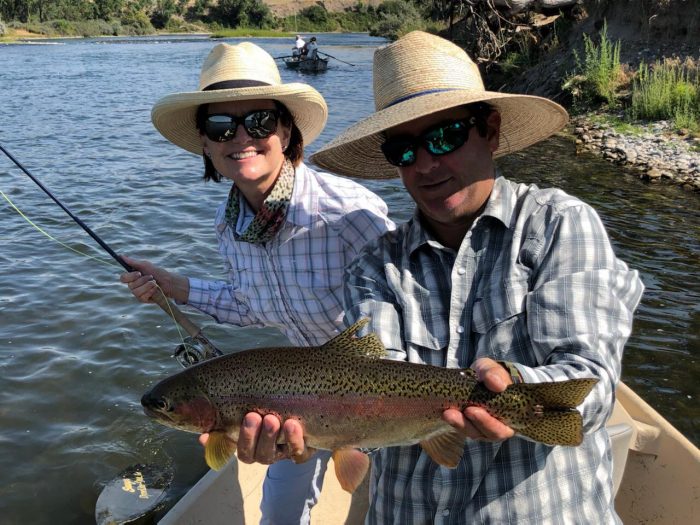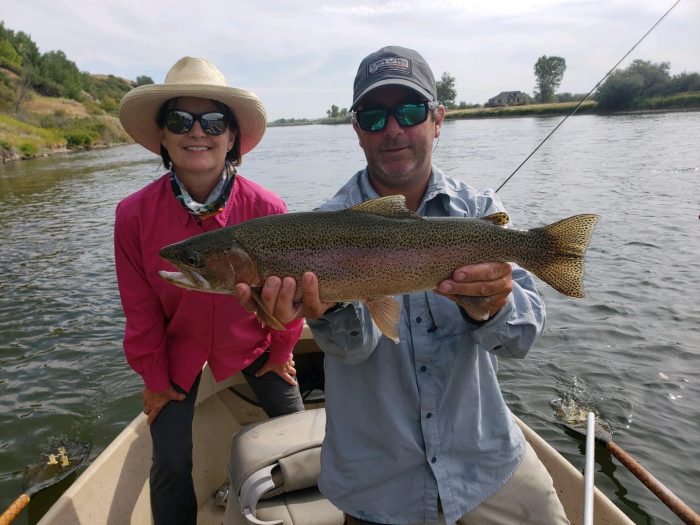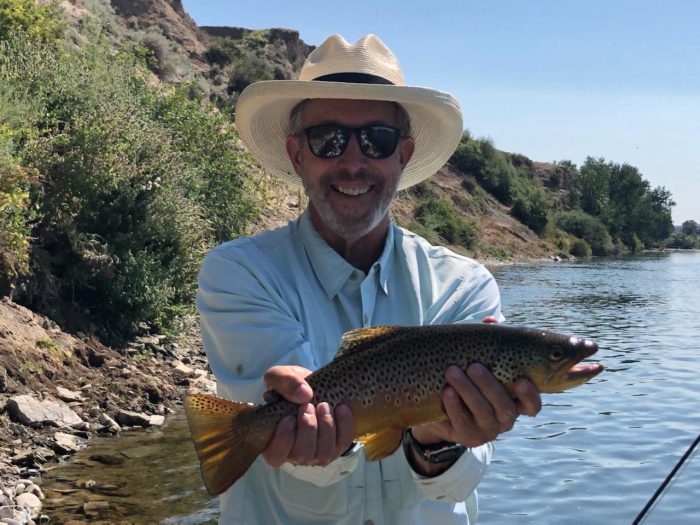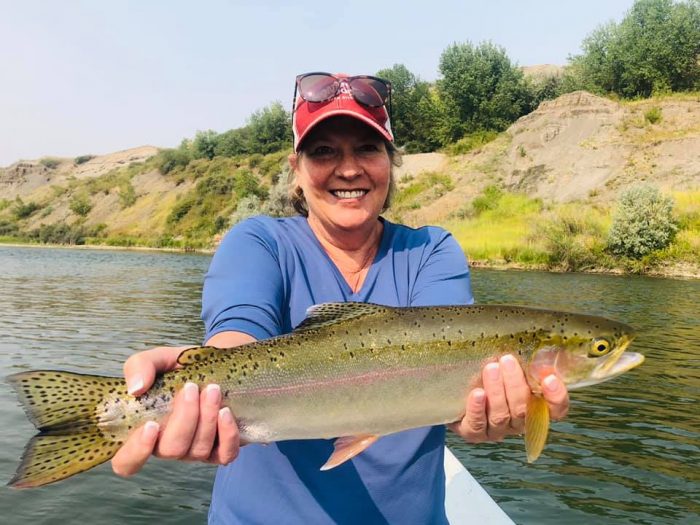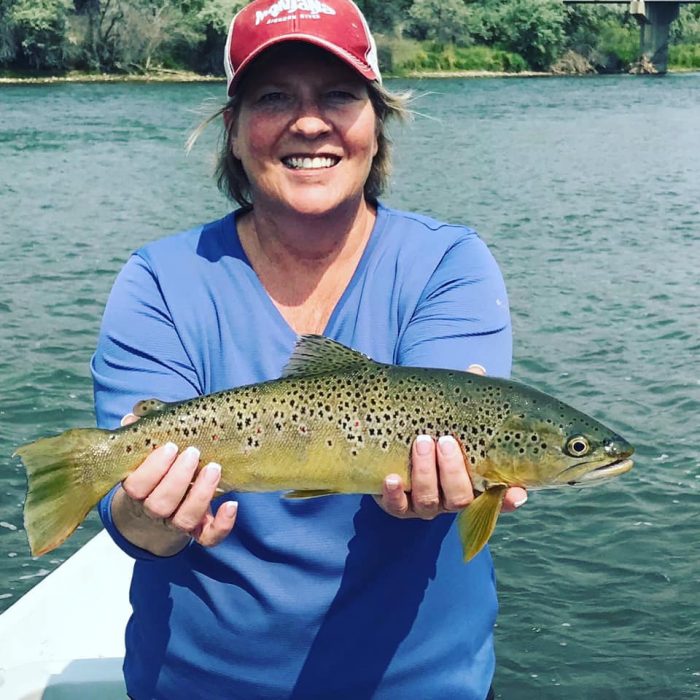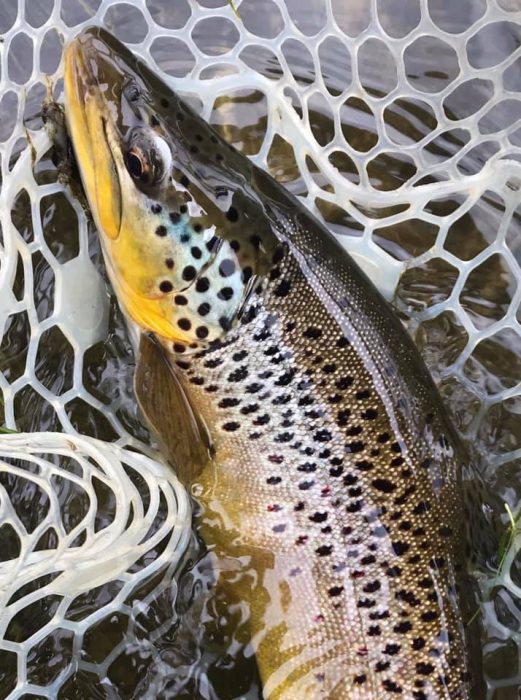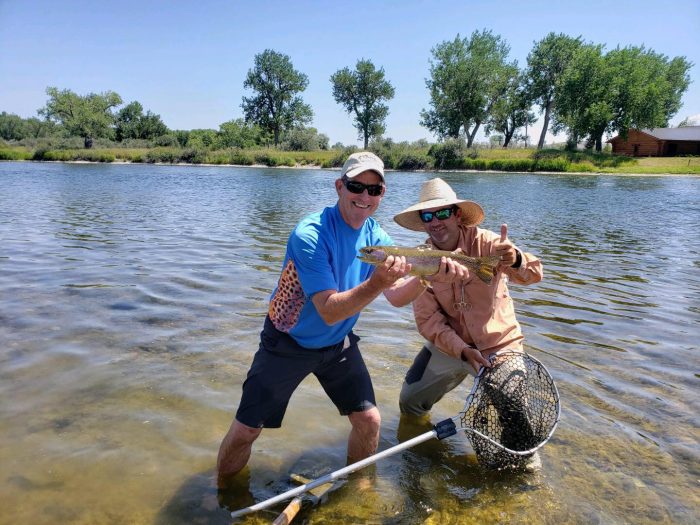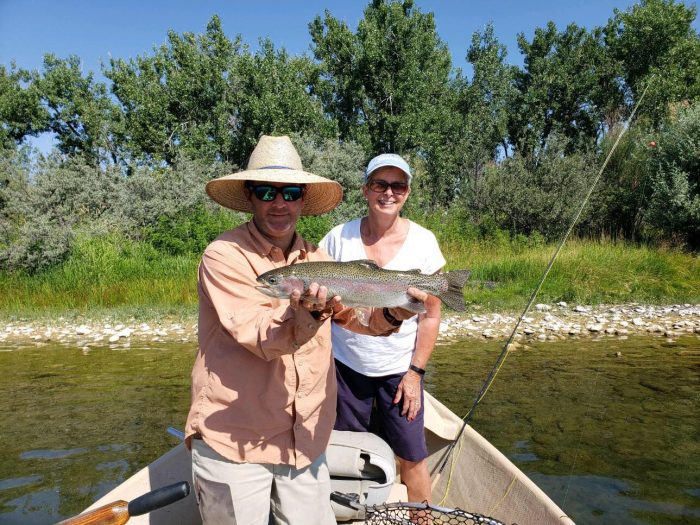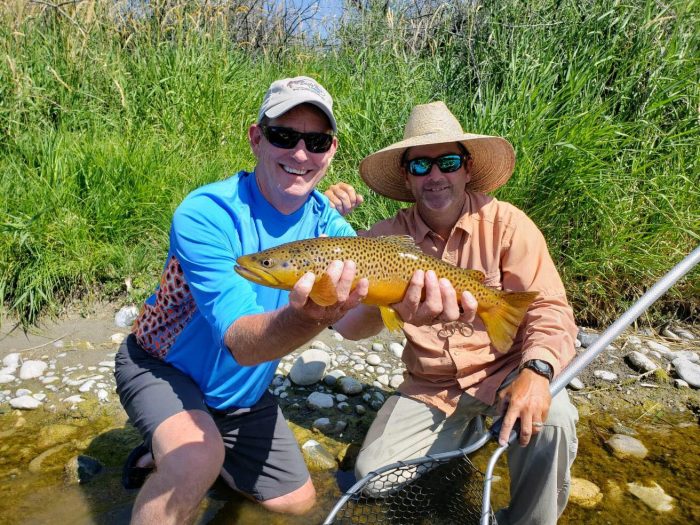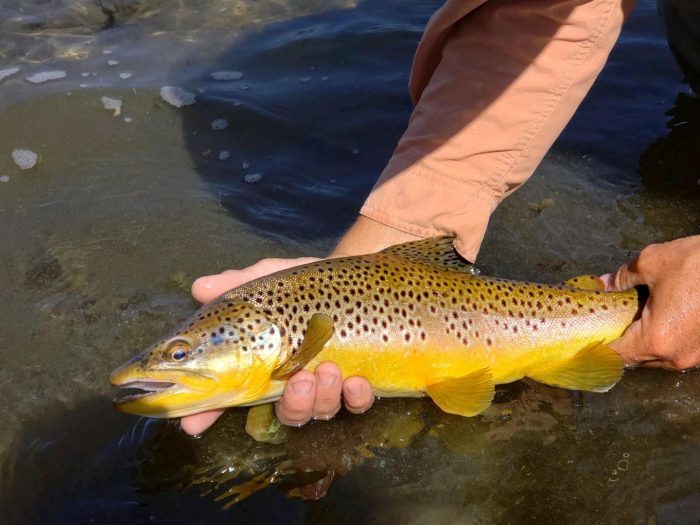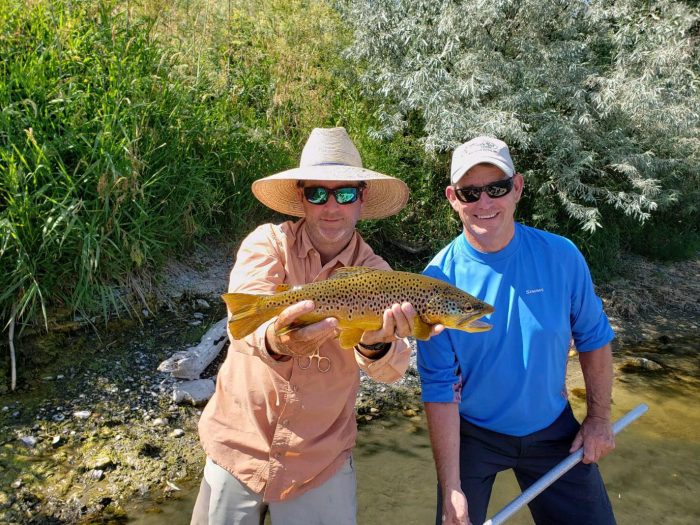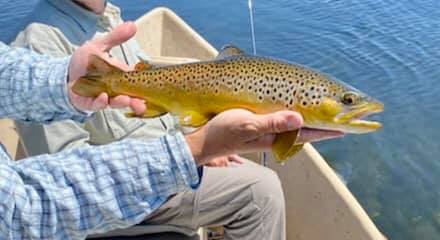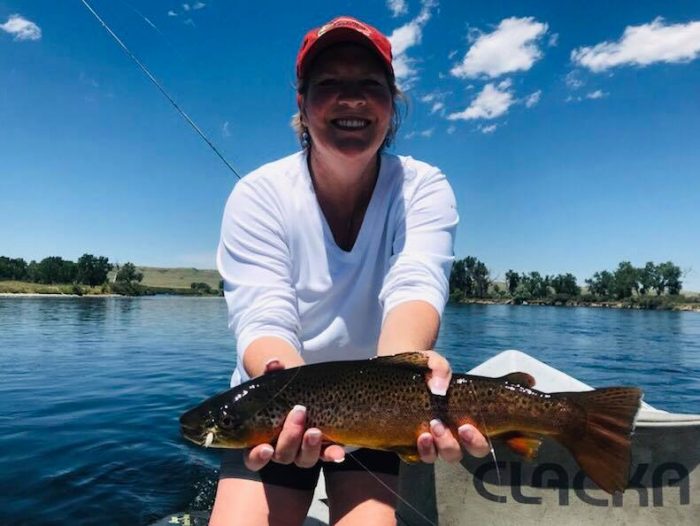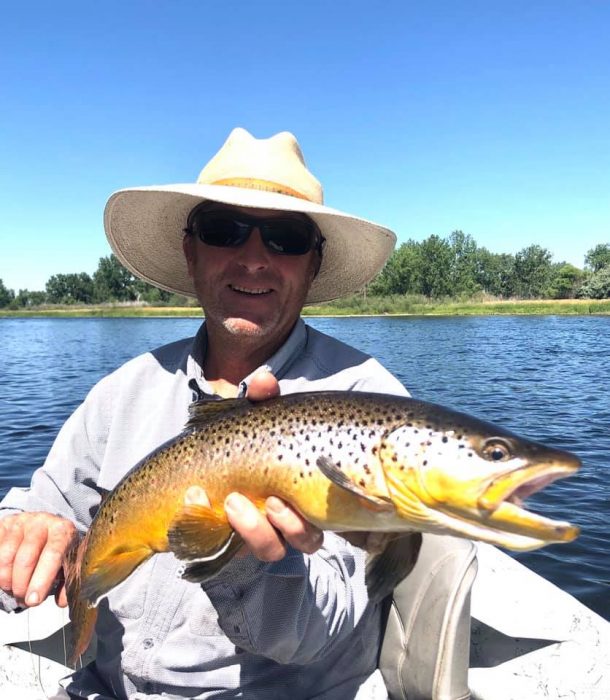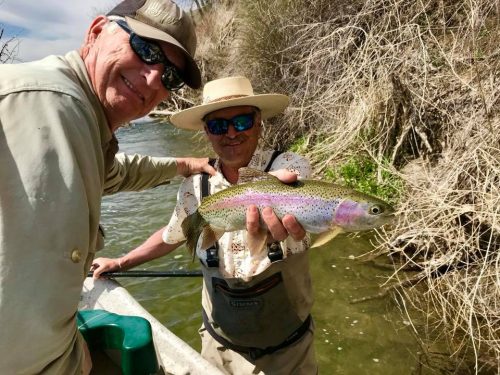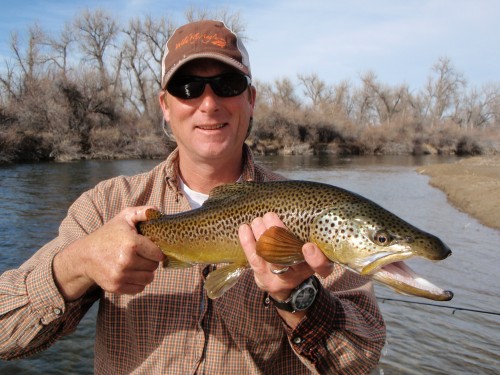Mary and Pat killed it on the Horn. Big fish, great fishing, and great times!
Even the Boss got to go fishing! Fishing is GREAT!
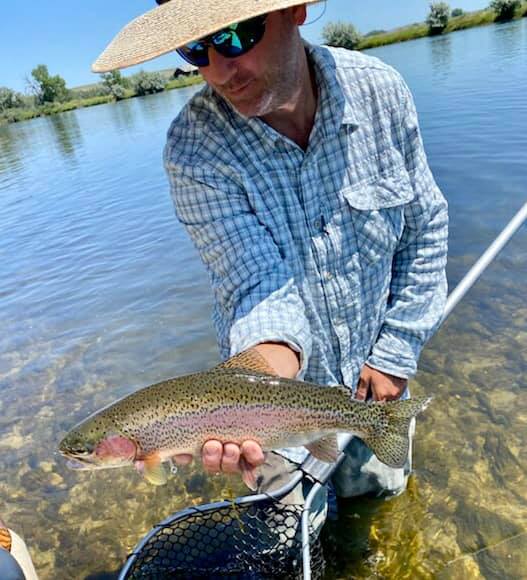
Keith and Gwen…always so much fun! Great times and great fishing!
May fishing on the Bighorn River in Montana
Don’t Fear The Worm!

Probably ought to start refilling that Steel Worm bin…
No, we are not talking about tequila (does anybody really do that?), but we are talking about that fly tied to the end of your leader. That’s right, the both mighty and humble worm. There are a bunch of various patterns that imitate this food organism to trout, from the original chenille San Juan, to the modern soft and chewy Squirmy Worm, to one of the Bighorn favorites, the Steel Worm. From the enthusiastic “Heck yeah, I love a good worm bite!”, to the “I am NOT, fishing a worm”, few flies are capable of evoking such strong opinions and reactions out of fly anglers.
Seasoned fishing guides and anglers generally fall into the enthusiastic camp when it comes to worms, and for good reason. Almost without fail, when these organisms are abundant and available to the trout, the fishing is typically very good. To better understand why this is, it helps to know a little bit about the humble worm. The first thing to understand is that the worms we are talking about are aquatic worms. That’s right, they live in the river. Rivers that are most abundant with aquatic worms generally have a low gradient (i.e. slower currents), are somewhat silty, and are nutritionally rich. Most Western tailwater rivers (rivers that are fed by a dam and large reservoir) meet this description. A few examples would include the North Platte in Wyoming, San Juan in New Mexico, and the Missouri, Beaverhead, and Bighorn in Montana. All of these rivers have the right combination of factors that make them aquatic worms factories, which significantly contribute to these river’s biomass and are one of the important reasons that they tend to produce healthy populations of decent sized trout.
Aquatic worms usually become abundant and available to trout during periods of higher river flows. As mountain runoff begins to melt and fill the reservoirs behind the dams, more water is released into the river in order to make room. These periods of higher flow in the spring tend to wash out accumulated silt, which is where aquatic worms generally live. As the silt is displaced into the current, so are the worms. Imagine a typical Bighorn River brown trout. You’re making a living throughout the year by eating a lot of really small bites; sowbug, scuds, midges, some caddis and mayflies, and an occasional minnow, snail or leech. In the fall you go through the annual spawning ritual and loose body mass as you devote a lot of energy into cutting redds (for females), chasing off competitive suiters (for males), and then laying and fertilizing eggs. As the spawn winds down it’s into December, and then come the lean months of winter, where you feed on sparse hatches of tiny midges, mayflies and the odd scud and sow bug in the drift. By spring you are ready to eat and put that body mass back on. As the days get longer, the water warms, the river rises, and suddenly there are hundreds of thousands of meaty aquatic worms drifting in the feeding lanes. Life is good! You take advantage of this opportunity and voraciously feed on these organisms, sometimes ignoring other food forms in order to efficiently put as many calories as possible in your body in the time given. In the span of a couple of weeks, you go from being pale, silvery, and skinny to a plump golden brown that the Bighorn is famous for.
The keen angler (and guide) takes advantage of this type of feeding behavior by the trout. It’s no different from taking advantage of the same behavior when hatching insects are abundantly available such as mayflies, caddis, stoneflies, and midges. Although the worm bite isn’t a “hatch” in the traditional sense, by fishing a worm pattern during these times, you are essentially “matching the hatch” by selecting a fly pattern that represents the food form most available to the trout. I know a guide who was flat out accused of not understanding aquatic entomology because he tied on a worm pattern for a client. That situation was rare and unfortunate, and only served to illustrate the ignorance of his client. However, it’s a lot less rare to meet an angler who doesn’t make insulting accusations, but turns their nose up at a worm pattern. Yes, it may not be as idilic as stalking a pod of rising trout sipping size 22 trico spinners from the surface with a perfectly tied flat wing spinner, but it is the same concept none-the-less.
So the next time you hop into a drift boat, and your guide ties on that simple little red, or purple, or brown, or wine chenille worm fly, don’t fear the worm! It’s not an insult or reflection on your angling ability, it is simply a matter of working with what the river happens to be dealing at that particular time. And if you really can’t get past it, look at booking your trip when those pods of trout are sipping sized 22 trico spinners, just make sure you’ve practiced hitting a dinner plate at 40 feet, but that’s another post for later!
Cheers!
From the Guide Shack…
Tyler
Bighorn River 2018 Runoff Forecast
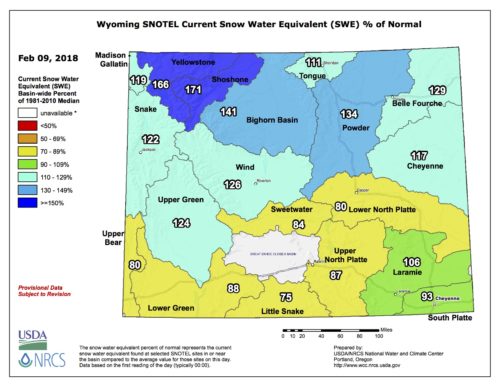
The Shoshone, Wind, and Bighorn Basins located in Wyoming, feed the Bighorn River here in Montana. This map shows near current snow water equivalents as a percentage of normal.
We have plenty of snow piling up in the Bighorn Valley, and more importantly, in the mountain ranges that feed the river!
Water is generally a good thing for rivers and trout. But the last few seasons, we have, at times, had too much of a good thing. This was especially obvious last spring when flows peaked at 15,000 cubic feet per second (cfs). The Bighorn River Alliance has been aggressively lobbying the US Bureau of Reclamation, which operates Yellowtail Dam here on the Bighorn, to be more proactive in dealing with water runoff in years when it is clear that there is going to be an excess. This year is shaping up to be a year of excess, with snowpack levels well above average in the Wind, Bighorn, and Shoshone Basins which feed the Bighorn River in Montana.
This week the Bureau of Reclamation (BOR), which operates the dam, released their spring runoff projections. The good news is that it appears the BOR is listening and planning accordingly in order to avoid extremely high flows this season. Current water releases out of Yellowtail Dam are at 4,500 cubic feet per second (cfs), which is higher than normal for this time of year. But this is a good thing, because it is making room in the reservoir for spring runoff that will come later. According to BOR, Bighorn River flows are expected to peak at about 7,000 cfs in May before dropping to 4,500 cfs in July.
This is great news! The river should have a ‘bump’ in spring flows. Increased flows in the spring helps cleanse the river of silt and algae which is good for insects and the trout that feed on them. Higher spring flows also facilitate better spring spawning conditions for rainbow trout. So having the river flow at 7000 cfs for a couple of months isn’t really a bad thing, and is extremely manageable from a fishing and guiding standpoint.
Generally speaking, the river tends to fish very good at these levels. We expect the spring nymph fishing will be very good. At the same time, we should still see good blue wing olive (baetis) and midge hatches in April and May. The predicted water levels will still be wadeable in spots, making it possible to take advantage of dry fly fishing opportunities.
Obviously we are keeping our fingers crossed that the Bureau of Reclamation’s projections will hold true, because if they do, it should set up some really good fishing conditions this spring!
Bighorn River Fishing report
It is fishing extremely well. The flow was at 3,000 cfs on Tuesday and the water temp was 39-40 degrees at the Afterbay. There has been a lot of dry fly activity from 10 a.m. on. Fish will take a Griffith’s gnat and cluster midge in size 16-20. Nymph fishermen should try a pink or tan firebead Ray Charles (14-16). Try a root beer midge pupa or cream midge pupa (18). A few guys are stripping streamers in black or olive wooly buggers. There haven’t been any signs of rainbows getting ready to spawn. That should start in mid-April.
